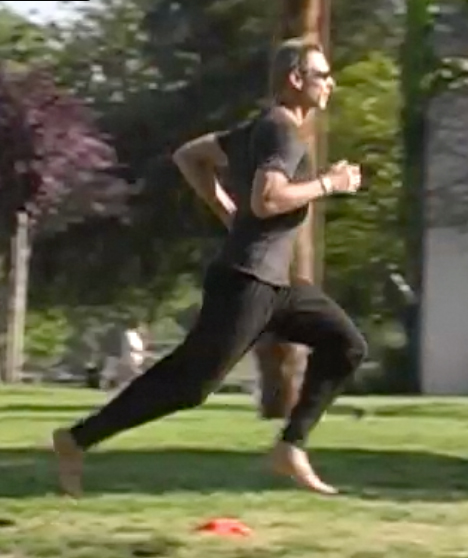
Just Let Go and Run
Even after all the "coaching" described in the last post, we're "still stuck to the ground. How do we complete the stride?" Simple. We change support. It's self-evident -- the foot has to let go of the ground. So, we bend the knee to lift the foot. This is known from the Pose perspective as the "pull."
It's worth mentioning that the pull picks up the foot, which is light (under 2 percent of bodyweight). A knee drive flexes the hip to raise the thigh, which is heavy (about 11 percent of bodyweight). Just saying.
Pull
Once the fall is complete and the GCM has been accelerated, all that's left to do is to get the foot off the ground. When performed correctly, this allows the other foot to find the ground and begin bearing weight on the BOF right as the GCM is passing above. This support endures a moment before it's pulled yet again as the stride continues. Running, then, is falling and changing support, and the pull is our last invariable.

Pull -- Release the Ground to Change Support
But, within this invariable, there's a variable. When? On time! This means that the correctness of the pull is determined by when support loses full bodyweight. But I'm not taking a scale or balance out with me on a run, and I'll wager neither are you. Ultimately, we need to know by feel when it's time to pull the foot from the ground.
In a perfect world, the pull is handled reflexively. In our world, shoes blunt our natural feedback mechanisms, the sensory acuity that provides for precise timing. As well, any willful intent of trying to do more -- paw, push, what-have-you -- as the foot is being drawn away from the ground only muddles this timing. So until our perception is re-sensitized we get to tell ourselves and teach ourselves to pull on time.
An Aside
Perhaps a surprising piece in this puzzle is that we're also subject to our natural fear of falling (one of two innate fears, the other being of loud noise). Fear of falling can have us reaching out with the swing foot to find terraferma as we continue clinging to the ground behind us. Running, then, could look a lot like walking.
But what if we reframe this fear as a cue? That is, that our support or the security of one bodyweight is coming to an end. Then, things can change. When we get comfortable giving ourselves freely to gravity and feeling the fall, we begin reacquainting ourselves with the primal grace that our earliest forebears enjoyed. Our senses will awaken and will tell us exactly "when." The Pose Method coaching gives us renewed access to learning these perceptual fluencies, and it gives them a voice -- pull!
I should also say that, while this isn't an exercise article, per se, it is worth knowing that using specific drills are more valuable than, for instance, just mindlessly increasing training mileage. We, as runners, want to reinforce these invariable elements of running that refine the specific skills set that ensures our most precise movements, and ultimately leads us to heightened perception. (I'll explore some of my favorite drills -- especially pulling drills -- in future posts.) As well, training with without shoes and on bare feet helps to revive our natural physical and mental awareness, too. Less is more!
Insofar as performance, endurance and speed rely on consistent execution -- high-quality technique. Technique depends on precise neural conditioning, which stems from increasing our awareness of incorrect and correct... timing. Drills are the direct route to becoming a safe and efficient runner, and training volume is valuable only insofar as our good technique can be maintained. With tens of millions of runners being injured by their sport each and every year, skills training may very well be the single most potent prophylactic we have available.
Conclusion
Again, I look back to our prehistory where, once down from the trees and exploring our new world with the great strength and dexterity of our hands and arms, the task of walking about was relegated to lower nerve function. Over time, as our intent carried us farther from our arboreal habitat and demanded greater levels of mobility, our bodies morphed into their present iteration. All this was occurring because we were unconsciously working with the dominating force of gravity to effect such physical changes. Cavemen probably didn't think much about running form, but we can be certain that to survive the day to day, they ran, and they ran right -- like any other wild beast. Nature saw to it.
You can witness such primal awareness in children as they routinely test the boundaries of balance and motion while learning to stand, to walk, and then to run. They use just the invariable elements -- Pose, fall, pull. It's only later, after their senses and freedom of movement have been blunted by footwear, and their inherent understanding of movement have been skewed by the prejudices of others that they must be taught, or more accurately reminded, of correct running form.
So, yes, running is so simple that even a caveman could do it. The question is, now that it's been distilled for you, down to its simplest form -- Pose, fall, pull -- can you do it, too?
Notes:
- Vertical Moment, Beginning Angle of Fall, and Ending Angle of Fall stride analyses are from a running stride presentation by Nicholas Romanov, PhD. at the American Pose Coaches Conference, 2012. Photos of presentation by Charles Blake, DPT.
For more by Christopher Drozd, click here.
For more on fitness and exercise, click here.